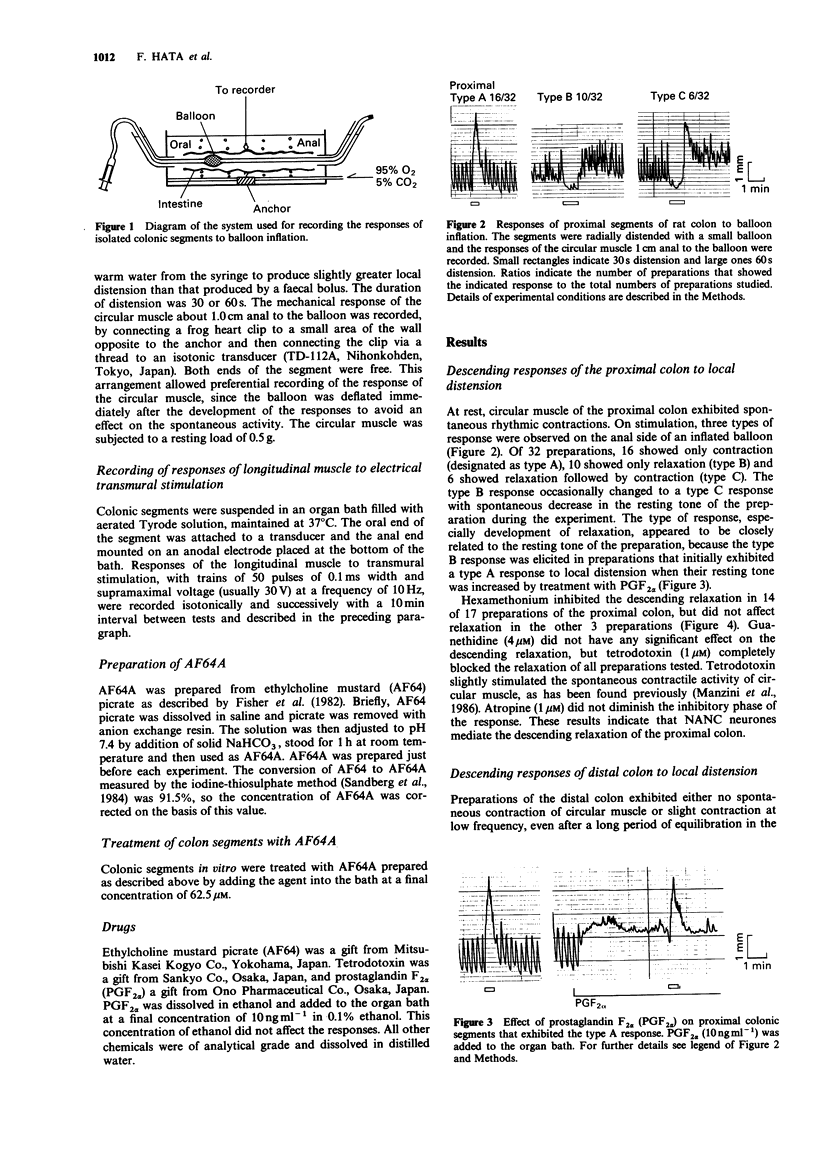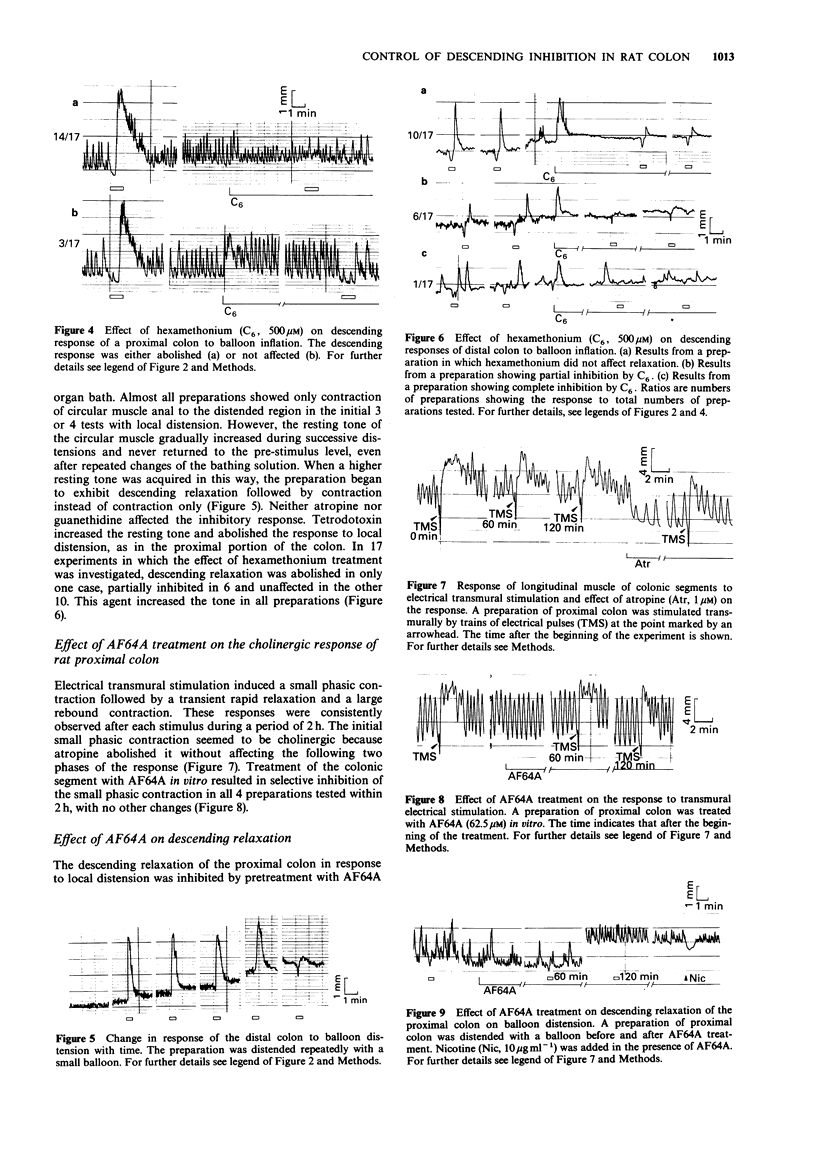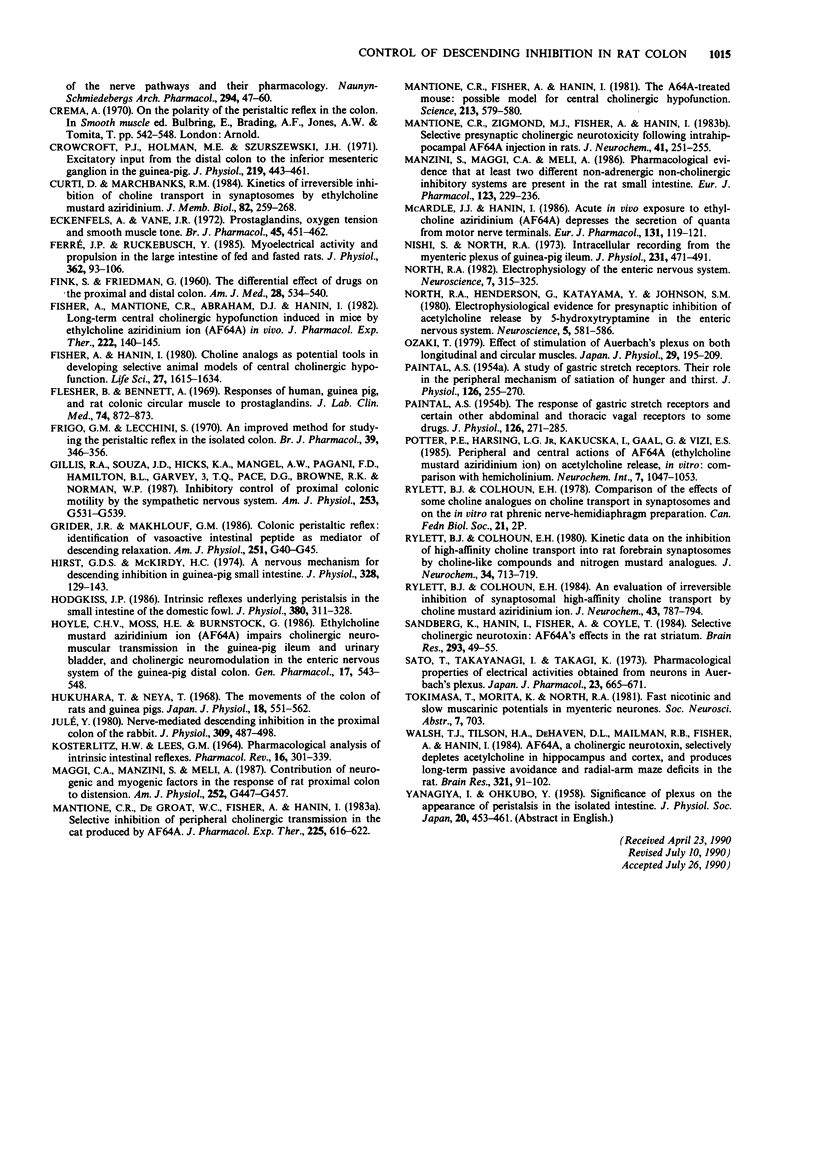Abstract
1. Descending inhibition in the proximal and distal portions of rat colon was studied separately, in vitro. 2. In the proximal colon, localized distension with a small balloon caused three types of response (contraction; relaxation; relaxation, then contraction) of the circular muscle on the anal side of the distended region. 3. Distension caused descending relaxation of circular muscle in all segments of the proximal colon, although for this prostaglandin F2 alpha (PGF 2 alpha) was necessary in some segments to increase muscle tone. 4. Atropine and guanethidine did not inhibit this descending relaxation, but tetrodotoxin did. 5. Hexamethonium inhibited the descending relaxation in 14 of 17 preparations of proximal colon tested, but not in the others. 6. In the distal colon, distension consistently caused an increase in the tone of the circular muscles. Descending relaxation was observed only after development of higher tone. Atropine and guanethidine did not inhibit the relaxation, but tetrodotoxin did. 7. Hexamethonium did not inhibit the descending relaxation in most of the preparations of distal colon examined. 8. AF64A, an inhibitor of choline uptake, inhibited the response mediated by cholinergic neurons in vitro to electrical transmural stimulation of the longitudinal muscle of proximal colon. 9. Treatment of colonic preparations with AF64A in vitro resulted in inhibition of descending relaxation in those of proximal, but not those of distal, colon. 10. The participation of intrinsic cholinergic neurones in the descending neuronal pathway is strongly suggested by the results in the proximal colon, but less so in the distal colon. 11. The tone and spontaneous contractile activity of colonic circular muscles are discussed in relation to their neuronal control.
Full text
PDF




Selected References
These references are in PubMed. This may not be the complete list of references from this article.
- Allen M. C. The effect of choline mustard on the rat superior cervical ganglia. Br J Pharmacol. 1983 Jun;79(2):489–497. doi: 10.1111/j.1476-5381.1983.tb11023.x. [DOI] [PMC free article] [PubMed] [Google Scholar]
- Bayliss W. M., Starling E. H. The movements and innervation of the small intestine. J Physiol. 1899 May 11;24(2):99–143. doi: 10.1113/jphysiol.1899.sp000752. [DOI] [PMC free article] [PubMed] [Google Scholar]
- Christensen J., Stiles M. J., Rick G. A., Sutherland J. Comparative anatomy of the myenteric plexus of the distal colon in eight mammals. Gastroenterology. 1984 Apr;86(4):706–713. [PubMed] [Google Scholar]
- Costa M., Furness J. B. The peristaltic reflex: an analysis of the nerve pathways and their pharmacology. Naunyn Schmiedebergs Arch Pharmacol. 1976 Jul;294(1):47–60. doi: 10.1007/BF00692784. [DOI] [PubMed] [Google Scholar]
- Crowcroft P. J., Holman M. E., Szurszewski J. H. Excitatory input from the distal colon to the inferior mesenteric ganglion in the guinea-pig. J Physiol. 1971 Dec;219(2):443–461. doi: 10.1113/jphysiol.1971.sp009671. [DOI] [PMC free article] [PubMed] [Google Scholar]
- Curti D., Marchbanks R. M. Kinetics of irreversible inhibition of choline transport in synaptosomes by ethylcholine mustard aziridinium. J Membr Biol. 1984;82(3):259–268. doi: 10.1007/BF01871635. [DOI] [PubMed] [Google Scholar]
- Eckenfels A., Vane J. R. Prostaglandins, oxygen tension and smooth muscle tone. Br J Pharmacol. 1972 Jul;45(3):451–462. doi: 10.1111/j.1476-5381.1972.tb08101.x. [DOI] [PMC free article] [PubMed] [Google Scholar]
- FINK S., FRIEDMAN G. The differential effect of drugs on the proximal and distal colon. Am J Med. 1960 Apr;28:534–540. doi: 10.1016/0002-9343(60)90147-9. [DOI] [PubMed] [Google Scholar]
- Ferré J. P., Ruckebusch Y. Myoelectrical activity and propulsion in the large intestine of fed and fasted rats. J Physiol. 1985 May;362:93–106. doi: 10.1113/jphysiol.1985.sp015665. [DOI] [PMC free article] [PubMed] [Google Scholar]
- Fisher A., Hanin I. Choline analogs as potential tools in developing selective animal models of central cholinergic hypofunction. Life Sci. 1980 Nov 3;27(18):1615–1634. doi: 10.1016/0024-3205(80)90635-9. [DOI] [PubMed] [Google Scholar]
- Fisher A., Mantione C. R., Abraham D. J., Hanin I. Long-term central cholinergic hypofunction induced in mice by ethylcholine aziridinium ion (AF64A) in vivo. J Pharmacol Exp Ther. 1982 Jul;222(1):140–145. [PubMed] [Google Scholar]
- Frigo G. M., Lecchini S. An improved method for studying the peristaltic reflex in the isolated colon. Br J Pharmacol. 1970 Jun;39(2):346–356. doi: 10.1111/j.1476-5381.1970.tb12898.x. [DOI] [PMC free article] [PubMed] [Google Scholar]
- Gillis R. A., Dias Souza J., Hicks K. A., Mangel A. W., Pagani F. D., Hamilton B. L., Garvey T. Q., 3rd, Pace D. G., Browne R. K., Norman W. P. Inhibitory control of proximal colonic motility by the sympathetic nervous system. Am J Physiol. 1987 Oct;253(4 Pt 1):G531–G539. doi: 10.1152/ajpgi.1987.253.4.G531. [DOI] [PubMed] [Google Scholar]
- Grider J. R., Makhlouf G. M. Colonic peristaltic reflex: identification of vasoactive intestinal peptide as mediator of descending relaxation. Am J Physiol. 1986 Jul;251(1 Pt 1):G40–G45. doi: 10.1152/ajpgi.1986.251.1.G40. [DOI] [PubMed] [Google Scholar]
- Hirst G. D., McKirdy H. C. A nervous mechanism for descending inhibition in guinea-pig small intestine. J Physiol. 1974 Apr;238(1):129–143. doi: 10.1113/jphysiol.1974.sp010514. [DOI] [PMC free article] [PubMed] [Google Scholar]
- Hodgkiss J. P. Intrinsic reflexes underlying peristalsis in the small intestine of the domestic fowl. J Physiol. 1986 Nov;380:311–328. doi: 10.1113/jphysiol.1986.sp016287. [DOI] [PMC free article] [PubMed] [Google Scholar]
- Hoyle C. H., Moss H. E., Burnstock G. Ethylcholine mustard aziridinium ion (AF64A) impairs cholinergic neuromuscular transmission in the guinea-pig ileum and urinary bladder, and cholinergic neuromodulation in the enteric nervous system of the guinea-pig distal colon. Gen Pharmacol. 1986;17(5):543–548. doi: 10.1016/0306-3623(86)90090-x. [DOI] [PubMed] [Google Scholar]
- Hukuhara T., Neya T. The movements of the colon of rats and guinea pigs. Jpn J Physiol. 1968 Aug 15;18(4):551–562. doi: 10.2170/jjphysiol.18.551. [DOI] [PubMed] [Google Scholar]
- Julé Y. Nerve-mediated descending inhibition in the proximal colon of the rabbit. J Physiol. 1980 Dec;309:487–498. doi: 10.1113/jphysiol.1980.sp013522. [DOI] [PMC free article] [PubMed] [Google Scholar]
- KOSTERLITZ H. W., LEES G. M. PHARMACOLOGICAL ANALYSIS OF INTRINSIC INTESTINAL REFLEXES. Pharmacol Rev. 1964 Sep;16:301–339. [PubMed] [Google Scholar]
- Maggi C. A., Manzini S., Meli A. Contribution of neurogenic and myogenic factors in the response of rat proximal colon to distension. Am J Physiol. 1987 Apr;252(4 Pt 1):G447–G457. doi: 10.1152/ajpgi.1987.252.4.G447. [DOI] [PubMed] [Google Scholar]
- Mantione C. R., Fisher A., Hanin I. The AF64a-treated mouse: possible model for central cholinergic hypofunction. Science. 1981 Jul 31;213(4507):579–580. doi: 10.1126/science.6894649. [DOI] [PubMed] [Google Scholar]
- Mantione C. R., Zigmond M. J., Fisher A., Hanin I. Selective presynaptic cholinergic neurotoxicity following intrahippocampal AF64A injection in rats. J Neurochem. 1983 Jul;41(1):251–255. doi: 10.1111/j.1471-4159.1983.tb11836.x. [DOI] [PubMed] [Google Scholar]
- Mantione C. R., deGroat W. C., Fisher A., Hanin I. Selective inhibition of peripheral cholinergic transmission in the cat produced by AF64A. J Pharmacol Exp Ther. 1983 Jun;225(3):616–622. [PubMed] [Google Scholar]
- Manzini S., Maggi C. A., Meli A. Pharmacological evidence that at least two different non-adrenergic non-cholinergic inhibitory systems are present in the rat small intestine. Eur J Pharmacol. 1986 Apr 16;123(2):229–236. doi: 10.1016/0014-2999(86)90664-3. [DOI] [PubMed] [Google Scholar]
- McArdle J. J., Hanin I. Acute in vivo exposure to ethylcholine aziridinium (AF64A) depresses the secretion of quanta from motor nerve terminals. Eur J Pharmacol. 1986 Nov 12;131(1):119–121. doi: 10.1016/0014-2999(86)90524-8. [DOI] [PubMed] [Google Scholar]
- Nishi S., North R. A. Intracellular recording from the myenteric plexus of the guinea-pig ileum. J Physiol. 1973 Jun;231(3):471–491. doi: 10.1113/jphysiol.1973.sp010244. [DOI] [PMC free article] [PubMed] [Google Scholar]
- North R. A. Electrophysiology of the enteric nervous system. Neuroscience. 1982 Feb;7(2):315–325. doi: 10.1016/0306-4522(82)90269-x. [DOI] [PubMed] [Google Scholar]
- North R. A., Henderson G., Katayama Y., Johnson S. M. Electrophysiological evidence for presynaptic inhibition of acetylcholine release by 5-hydroxytryptamine in the enteric nervous system. Neuroscience. 1980;5(3):581–586. doi: 10.1016/0306-4522(80)90055-x. [DOI] [PubMed] [Google Scholar]
- Ozaki T. Effects of stimulation of Auerbach's plexus on both longitudinal and circular muscles. Jpn J Physiol. 1979;29(2):195–209. doi: 10.2170/jjphysiol.29.195. [DOI] [PubMed] [Google Scholar]
- PAINTAL A. S. A study of gastric stretch receptors; their role in the peripheral mechanism of satiation of hunger and thirst. J Physiol. 1954 Nov 29;126(2):255–270. doi: 10.1113/jphysiol.1954.sp005207. [DOI] [PMC free article] [PubMed] [Google Scholar]
- PAINTAL A. S. The response of gastric stretch receptors and certain other abdominal and thoracic vagal receptors to some drugs. J Physiol. 1954 Nov 29;126(2):271–285. doi: 10.1113/jphysiol.1954.sp005208. [DOI] [PMC free article] [PubMed] [Google Scholar]
- Rylett B. J., Colhoun E. H. Kinetic data on the inhibition of high-affinity choline transport into rat forebrain synaptosomes by choline-like compounds and nitrogen mustard analogues. J Neurochem. 1980 Mar;34(3):713–719. doi: 10.1111/j.1471-4159.1980.tb11202.x. [DOI] [PubMed] [Google Scholar]
- Rylett R. J., Colhoun E. H. An evaluation of irreversible inhibition of synaptosomal high-affinity choline transport by choline mustard aziridinium ion. J Neurochem. 1984 Sep;43(3):787–794. doi: 10.1111/j.1471-4159.1984.tb12800.x. [DOI] [PubMed] [Google Scholar]
- Sandberg K., Hanin I., Fisher A., Coyle J. T. Selective cholinergic neurotoxin: AF64A's effects in rat striatum. Brain Res. 1984 Feb 13;293(1):49–55. doi: 10.1016/0006-8993(84)91451-3. [DOI] [PubMed] [Google Scholar]
- Sato T., Takayanagi I., Takagi K. Pharmacological properties of electrical activities obtained from neurons in Auerbach's plexus. Jpn J Pharmacol. 1973 Oct;23(5):665–671. doi: 10.1254/jjp.23.665. [DOI] [PubMed] [Google Scholar]
- Walsh T. J., Tilson H. A., DeHaven D. L., Mailman R. B., Fisher A., Hanin I. AF64A, a cholinergic neurotoxin, selectively depletes acetylcholine in hippocampus and cortex, and produces long-term passive avoidance and radial-arm maze deficits in the rat. Brain Res. 1984 Oct 29;321(1):91–102. doi: 10.1016/0006-8993(84)90684-x. [DOI] [PubMed] [Google Scholar]


